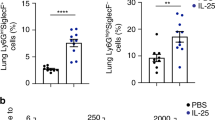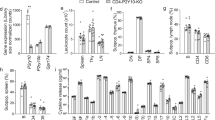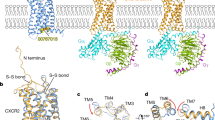Abstract
Polymorphonuclear leukocytes (PMNs) are critical effector cells of the innate immune system that protect the host by migrating to inflammatory sites and killing pathogenic microbes. We addressed the role of chemokine receptor desensitization induced by G-protein-coupled receptor kinases (GRKs) in the feedback control of PMN migration. We show that the chemokine macrophage inflammatory protein-2 (MIP-2) induces GRK2 and GRK5 expression in PMNs through phosphoinositide-3-kinase (PI3K)-γ signaling. We also show that lipopolysaccharide (LPS)-activated signaling through the Toll-like receptor (TLR)-4 pathway transcriptionally downregulates the expression of GRK2 and GRK5 in response to MIP-2. The reduced expression of GRKs lowers chemokine receptor desensitization and markedly augments the PMN migratory response. These data indicate that TLR4 modulation of PMN surface chemokine receptor expression subsequent to the downregulation of GRK2 and GRK5 expression is a critical determinant of PMN migration.
This is a preview of subscription content, access via your institution
Access options
Subscribe to this journal
Receive 12 print issues and online access
$209.00 per year
only $17.42 per issue
Buy this article
- Purchase on Springer Link
- Instant access to full article PDF
Prices may be subject to local taxes which are calculated during checkout






Similar content being viewed by others
References
Ulevitch, R.J. Toll gates for pathogen selection. Nature 401, 755–756 (1999).
Baggiolini, M. Chemokines and leukocyte traffic. Nature 392, 565–568 (1998).
Lefkowitz, R.J. G protein-coupled receptors. III. New roles for receptor kinases and β-arrestins in receptor signaling and desensitization. J. Biol. Chem. 273, 18677–18680 (1998).
Gainetdinov, R.R. et al. Muscarinic supersensitivity and impaired receptor desensitization in G protein-coupled receptor kinase 5-deficient mice. Neuron 24, 1029–1036 (1999).
Benovic, J.L., DeBlasi, A., Stone, W.C., Caron, M.G. & Lefkowitz, R.J. β-adrenergic receptor kinase: primary structure delineates a multigene family. Science 246, 235–240 (1989).
Hisatomi, O. et al. A novel subtype of G-protein-coupled receptor kinase, GRK7, in teleost cone photoreceptors. FEBS Lett. 424, 159–164 (1998).
Penn, R.B., Pronin, A.N. & Benovic, J.L. Regulation of G protein-coupled receptor kinases. Trends Cardiovasc. Med. 10, 81–89 (2000).
Penn, R.B. & Benovic, J.L. Structure of the human gene encoding the β-adrenergic receptor kinase. J. Biol. Chem. 269, 14924–14930 (1994).
McGraw, D.W. & Liggett, S.B. Heterogeneity in β-adrenergic receptor kinase expression in the lung accounts for cell-specific desensitization of the β2-adrenergic receptor. J. Biol. Chem. 272, 7338–7344 (1997).
Eckhart, A.D., Ozaki, T., Tevaearai, H., Rockman, H.A. & Koch, W.J. Vascular-targeted overexpression of G protein-coupled receptor kinase-2 in transgenic mice attenuates β-adrenergic acceptor signaling and increases resting blood pressure. Mol. Pharmacol. 61, 749–758 (2002).
Rietschel, E.T. et al. Bacterial endotoxin: molecular relationships of structure to activity and function. FASEB J. 8, 217–225 (1994).
Poltorak, A. et al. Defective LPS signaling in C3H/HeJ and C57BL/10ScCr mice: mutations in Tlr4 gene. Science 282, 2085–2088 (1998).
Qureshi, S.T. et al. Endotoxin-tolerant mice have mutations in Toll-like receptor 4 (Tlr4). J. Exp. Med. 189, 615–625 (1999).
Hoshino, K. et al. Cutting edge: Toll-like receptor 4 (TLR4)-deficient mice are hyporesponsive to lipopolysaccharide: evidence for TLR4 as the Lps gene product. J. Immunol. 162, 3749–3752 (1999).
Sasaki, T. et al. Function of PI3Kγ in thymocyte development, T cell activation, and neutrophil migration. Science 287, 1040–1046 (2000).
Huang, J., Wang, M.D., Lenz, S., Gao, D. & Kaltenboeck, B. IL-12 administered during Chlamydia psittaci lung infection in mice confers immediate and long-term protection and reduces macrophage inflammatory protein-2 level and neutrophil infiltration in lung tissue. J. Immunol. 162, 2217–2226 (1999).
Xing, Z. et al. IL-6 is an antiinflammatory cytokine required for controlling local or systemic acute inflammatory responses. J. Clin. Invest. 101, 311–320 (1998).
Medzhitov, R. Toll-like receptors and innate immunity. Nat. Rev. Immunol. 1, 135–145 (2001).
May, M.J. et al. Selective inhibition of NFκB activation by a peptide that blocks the interaction of NEMO with the IκB kinase complex. Science 289, 1550–1554 (2000).
Favata, M.F. et al. Identification of a novel inhibitor of mitogen-activated protein kinase kinase. J. Biol. Chem. 273, 18623–18632 (1998).
Lloyd, A.R. et al. Granulocyte-colony stimulating factor and lipopolysaccharide regulate the expression of interleukin 8 receptors on polymorphonuclear leukocytes. J. Biol. Chem. 270, 28188–28192 (1995).
Khandaker, M.H. et al. CXCR1 and CXCR2 are rapidly down-modulated by bacterial endotoxin through a unique agonist-independent, tyrosine kinase-dependent mechanism. J. Immunol. 161, 1930–1938 (1998).
Kaplan, A.P. Chemokines, chemokine receptors and allergy. Int. Arch. Allergy Immunol. 124, 423–431 (2001).
Lira, S. Lessons from gene modified mice. Forum (Genova) 9, 286–298 (1999).
Cacalano, G. et al. Neutrophil and B cell expansion in mice that lack the murine IL-8 receptor homolog. Science 265, 682–684 (1994).
Wiekowski, M.T. et al. Disruption of neutrophil migration in a conditional transgenic model: evidence for CXCR2 desensitization in vivo. J. Immunol. 167, 7102–7110 (2001).
Khandaker, M.H. et al. Metalloproteinases are involved in lipopolysaccharide- and tumor necrosis factor-α-mediated regulation of CXCR1 and CXCR2 chemokine receptor expression. Blood 93, 2173–2185 (1999).
Kalmar, J.R. & Van Dyke, T.E. Effect of bacterial products on neutrophil chemotaxis. Methods Enzymol. 236, 58–87 (1994).
Hunter, R. Standardization of the chloramine-T method of protein iodination. Proc. Soc. Exp. Biol. Med. 133, 989–992 (1970).
Yoshizumi, M., Abe, J., Haendeler, J., Huang, Q. & Berk, B.C. Src and Cas mediate JNK activation but not ERK1/2 and p38 kinases by reactive oxygen species. J. Biol. Chem. 275, 11706–11712 (2000).
Bennett, B.L. et al. SP600125, an anthrapyrazolone inhibitor of Jun N-terminal kinase. Proc. Natl. Acad. Sci. USA 98, 13681–13686 (2001).
Szucs, S., Varga, C., Ember, I. & Kertai, P. The separation of the granulocytes from different rat strains. A comparative study. J. Immunol. Methods 167, 245–251 (1994).
Fan, J., Frey, R.S., Rahman, A. & Malik, A.B. Role of neutrophil NADPH oxidase in the mechanism of tumor necrosis factor-α-induced NFκB activation and intercellular adhesion molecule-1 expression in endothelial cells. J. Biol. Chem. 277, 3404–3411 (2002).
Fan, J. et al. Regulation of Toll-like receptor 4 expression in the lung following hemorrhagic shock and lipopolysaccharide. J. Immunol. 168, 5252–5259 (2002).
Johnston, J.A. et al. Human T lymphocyte chemotaxis and adhesion induced by vasoactive intestinal peptide. J. Immunol. 153, 1762–1768 (1994).
Edwards, J.C., Sedgwick, A.D. & Willoughby, D.A. The formation of a structure with the features of synovial lining by subcutaneous injection of air: an in vivo tissue culture system. J. Pathol. 134, 147–156 (1981).
Fan, G.H., Yang, W., Wang, X.J., Qian, Q. & Richmond, A. Identification of a motif in the carboxyl terminus of CXCR2 that is involved in adaptin 2 binding and receptor internalization. Biochemistry 40, 791–800 (2001).
Acknowledgements
This work was supported by US National Institutes of Health grants T32 HL07829, HL45638, HL60678 and HL27016.
Author information
Authors and Affiliations
Corresponding author
Ethics declarations
Competing interests
The authors declare no competing financial interests.
Rights and permissions
About this article
Cite this article
Fan, J., Malik, A. Toll-like receptor-4 (TLR4) signaling augments chemokine-induced neutrophil migration by modulating cell surface expression of chemokine receptors. Nat Med 9, 315–321 (2003). https://doi.org/10.1038/nm832
Received:
Accepted:
Published:
Issue Date:
DOI: https://doi.org/10.1038/nm832
This article is cited by
-
GRK2 regulates group 2 innate lymphoid cell mobilization in sepsis
Molecular Medicine (2022)
-
Exosomal miR-30d-5p of neutrophils induces M1 macrophage polarization and primes macrophage pyroptosis in sepsis-related acute lung injury
Critical Care (2021)
-
Effect of lipopolysaccharide and polyinosinic:polycytidylic acid in a murine model of nasal polyp
Scientific Reports (2021)
-
Lipopolysaccharides increase the risk of colorectal cancer recurrence and metastasis due to the induction of neutrophil extracellular traps after curative resection
Journal of Cancer Research and Clinical Oncology (2021)
-
Toll-like receptors: exploring their potential connection with post-operative infectious complications and cancer recurrence
Clinical & Experimental Metastasis (2020)



